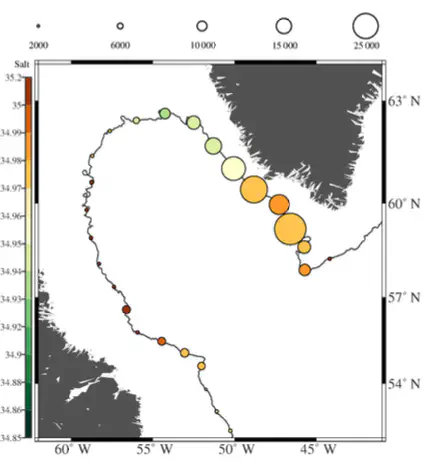 The probability of crossings per 100 km along the bound- ary is indicated by the size of the circles, with larger circles indi- cating a larger probability. The color shows the mean salinity of the crossings at each section.
The probability of crossings per 100 km along the bound- ary is indicated by the size of the circles, with larger circles indi- cating a larger probability. The color shows the mean salinity of the crossings at each section.
Abstract
The Labrador Sea plays an important role in the Meridional Overturning Circulation (MOC), due to the seasonal occurrence of deep convection in this region. Heat loss during mixing is balanced by heat import from the boundaries, while the seasonal freshening plays an important role in the restratification of the water column. Recent increases in freshwater input to high latitudes through accelerated rates of pack ice and glacial melt, has the potential to a↵ect the convection in the Labrador Sea and therefore the global ocean circulation. It is more important than ever to understand the influence these changes have on the dynamics in the Labrador Sea. Understanding pathways of freshwater fluxes into the region of deep convection and the impact of storms on the mixing in the Labrador Sea will help to predict potential changes in the MOC. To analyse recent changes in freshwater water in the Labrador Sea, an ARGO-based heat and freshwater budget of the Labrador Sea is calculated for 2002 – 2011. Over this time period a freshening of the surface waters (0 – 100 m) is observed. Between the first and second 5-year period, observations indicate a gain of 40 cm of freshwater to the surface. The surface freshening is comparable to past freshening periods associated with a reduction of deep convection (e.g. the Great Salinity Anomaly). However, the observed surface freshening is o↵set by subsurface warm- ing and enhanced salinities (100 – 2000 m), distinguishing it from the past freshening periods. To investigate pathways of freshwater fluxes a particle tracking tool is used in a NEMO 1/12o ocean model. Seasonally, two peaks of freshening are observed (in spring and fall), consistent with observations. The freshening is due to the freshwater content of the coastal water along the coast of Greenland and the rate of advection of West Greenland Water. The large year-to-year variability in advection can mainly be attributed to changes in Ekman transport. The relationship of convection to air-sea fluxes and the character of observed mixed layers in the Labrador Sea are explored by using wintertime hydrographic data from February – March 1997. The greatest number of storms occurred in December 1996 but the strongest winds and highest heat fluxes were observed in February 1997. Analysing storm tracks showed that storms in February 1997 followed more organized tracks extending from the Gulf Stream region to the Irminger Sea where they slowed and deepened. Investigation of the small scale variability within the mixed layers reveals that temperature and salinity intrusions are more common at the base of the mixes layers. During storms there were more non-density compensating intrusions present compared to the periods between storms, and the small scale variability was enhanced near the top of the mixed layers. This study underlines the importance of understanding the mechanisms through which water can reach the basin and potential implications of changes in the storm frequency and tracks under a changing climate.